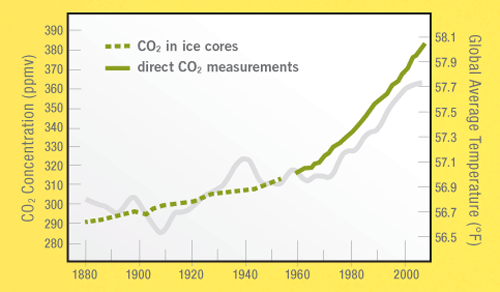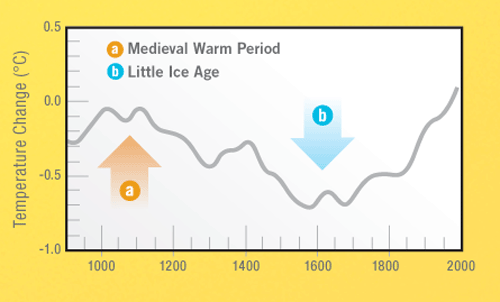
Global Warming’s Solar Connection
The Science
Based on typical news reports, you would assume that the cause of global warming is obvious—coal and burning gasoline. But we should look closer at a more obvious source of fluctuation. What about the sun?
Many people today are worried that global warming is threatening life on earth. They often blame pollution from modern industry, which is increasing the amount of certain atmospheric gases, such as carbon dioxide, that trap heat. Some individuals have gone so far as to say that we must take immediate action to halt global warming to prevent catastrophic consequences within the next century. What are we to make of such claims?
Warming Is Real
First, there is evidence that global warming is indeed happening. Virtually all the glaciers in the world have receded in the last century. Measurements indicate that the earth’s global average temperature has gone up 1.2°F (0.7°C) since 1880. This really isn’t very much of a change, and there is some reason to believe that even that number may be inflated.1 In any case, there is good reason to believe that the earth has warmed in the last century, if only slightly.
Is Carbon Dioxide a Bad Thing?
In addition, we know that industry releases certain gases into the atmosphere, and many of these gases, such as carbon dioxide and methane, tend to reflect infrared radiation. This means that they trap heat and warm the earth much the way a greenhouse does—hence the term the “greenhouse effect.” Theoretically, an increase in the abundance of these greenhouse gases will trap more heat, leading to an increase in the earth’s temperature. In reality, it’s far more complicated than this.2 Let’s consider a few important facts.
First, we should note that the greenhouse effect is a very good thing. Without this effect the earth’s temperature would be significantly lower (perhaps a difference of 60°F [33°C]), which would make human life nearly impossible. Greenhouse gases are a natural component of the atmosphere and are vital for human life. Moreover, carbon dioxide is essential for plant biology.
Second, carbon dioxide and other gases that are put into the atmosphere by industry are only minor contributions to the greenhouse effect. Contrary to popular belief, water vapor is far more significant to the greenhouse effect than carbon dioxide. Some have estimated that water vapor is responsible for as much as 95% of greenhouse warming.3
Third, changes in atmospheric carbon dioxide do not always correlate well with changes in the earth’s temperature. For example, the earth’s temperature rose substantially from 1910 to 1940, yet the carbon dioxide levels rose only slightly.4 Conversely, the global temperature has been falling since 2002, even though carbon dioxide levels continue to rise. There were substantial changes in climate in the ninth and seventeenth centuries, and yet these certainly cannot be due to carbon dioxide produced by industry.
The Sun’s Role
We must understand that the most important natural factor in determining the earth’s temperature is the sun. We take for granted that the sun is stable and warms the earth in a uniform way.
For the most part, it does; it is an unusually stable star. But the sun does have natural cycles and minor changes in intensity that affect climate on the earth. One such cycle is the relatively short-term sunspot cycle. However, much longer variations may also exist. There is evidence that such variations have a substantial effect on earth’s climate.
Sunspots are small,5 darker regions on the sun’s visible surface. There the solar material is substantially cooler than its surroundings, so it does not glow as brightly. The number of spots on the sun is highly variable. Sometimes the sun has more than fifty spots on its visible surface. At other times it has none. This is because the sunspot number is cyclic, changing from very few to many with a period of 11 years. This 11-year period is now known to be half of the sun’s 22-year magnetic cycle. (The sun is like a big magnet that reverses its polarity every 11 years, and so returns to its original polarity every 22 years.)
Sunspots do seem to correlate significantly with climate on earth. When sunspot activity is high, the regions surrounding the spots form small bright points called faculae.
Since the faculae are bright, they slightly overcompensate for the dimming effect of the spots, which causes the overall intensity of the sun to be higher than it would be without sunspots. So we would expect earth’s temperatures to be higher when sunspot activity is high—and this is indeed what we find.6
In addition to the 22-year cycle, sunspots also undergo variations on a much larger timescale. These correlate very well with temperatures on earth. For example, sunspot activity was very low during the period roughly spanning 1645–1715. This period of reduced sunspot activity is called the Maunder Minimum. It corresponds well with the period of colder temperatures experienced in Europe, known as the “Little Ice Age.”
A similar though less severe period of low sunspot activity, known as the Dalton Minimum, occurred during the period 1790–1830. It also coincided with reduced temperatures. Conversely, the Medieval Warm Period (AD ~1000) seems to correspond with a period of high sunspot activity.7 In addition, sunspot activity has been on the decline in the last decade, and we have been experiencing global cooling since 2002.
These correlations imply that long-term variations in solar activity have much more to do with global climate change than human activity. Furthermore, they also suggest that global warming is not a runaway effect on earth, contrary to what ecological extremists and their political allies would have us believe. Rather, the earth has long-term natural variations. It may be that the cooling trend we are now seeing marks the beginning of the downward part of the cycle, in which case we should expect to see slightly cooler temperatures over the next several decades. In any case, it seems that the claims of the global warming alarmists are unwarranted.
Yes, the Christian does have an obligation to care for God’s creation. We must take this seriously. At the same time, we must recognize that the earth and sun do go through natural cycles, and have been doing so for some time (Genesis 1:14–18).
Although the relationship between solar activity and earth’s climate may be only partially understood, it is clear that modern industry was not responsible for the Medieval Warming Period or the Little Ice Age. These periods of climate change were temporary and did not result in catastrophic destruction; they remind us that we can rely on the stability that God has placed in the natural world.
Indeed, God has promised that the cycles of nature will continue in the future as long as the world remains (Genesis 8:22).
A Look at the Numbers
Identifying the cause of global warming is very complex. Changes in carbon dioxide (CO2) do not correlate well with temperature changes. But changes in the sun’s activity do appear to correlate with major climate changes over the past few centuries.
THE SIGNIFICANCE OF CO2Several gases trap heat on earth. The main “greenhouse gas” is water vapor, but carbon dioxide (CO2) also has this effect. Increases in CO2 levels are now blamed for rising temperatures. But look closely at the graph below. If the CO2 level has increased steadily, why did the earth experience two periods of falling temperatures (after 1900 and after 1940)? Is there a better explanation for temperature change?

SIGNIFICANCE OF CO2 CHART: Global temperature: National Climatic Data Center CO2 measurements: Carbon Dioxide Information Analysis Center
THE SIGNIFICANCE OF THE SUNRising and falling temperature is not a new problem. Consider the past 1,000 years, especially the Medieval Warming Period and the Little Ice Age. Clearly the fossil fuel industry had nothing to do with these changes.
Another factor that may help explain temperature changes is the sun. The sun’s intensity goes through cycles not yet fully understood. The number of sunspots, for example, varies over a 22-year cycle, as the sun reverses magnetism. High sunspot activity is associated with higher temperatures on earth.
Sunspots also undergo variations on a much larger timescale. For example, sunspot activity was very low during the period 1645–1715, at the depth of the Little Ice Age. In contrast, sunspot activity was high during the Medieval Warm Period.

SIGNIFICANCE OF THE SUN CHART: Derived from Moberg et al. Nature, 2005
Answers Magazine
July – September 2010
From subtropical Madagascar to Antarctica, from frozen deserts to poisonous submarine volcanoes, creatures seem to inhabit every corner of the globe. How can they survive so well under so many different conditions? This issue includes a special section that examines life at the extremes, where God’s creative power continues to astound and delight us!
Browse IssueFootnotes
- Michael Oard, The New Answers Book 3, chapter 7, p. 77.
- The effect of greenhouse gases is nonlinear. This means that doubling the amount of a greenhouse gas does not necessarily double the greenhouse effect. Additionally, some greenhouse contributors actually have an overall cooling effect. For example, clouds do trap heat and are considered a contributor to the greenhouse effect. (This is why cloudy winter nights are usually warmer than clear winter nights.) But during the day, clouds reflect sunlight, which prevents solar energy from reaching the surface of the earth. This latter effect more than compensates for the former. So the net effect of clouds is that they actually reduce the earth’s temperature. The effect is also highly dependent on altitude.
- P. J. Michaels and R. C. Balling, Jr., “The Satanic Gases: Clearing the Air about Global Warming” (Washington D. C.: CATO Institute, 2000), p. 2.
- See figure 2 at http://www.icr.org/article/does-carbon-dioxide-drive-global-warming/
- The sun is over 100 times larger than earth in diameter. Sunspots are only about the size of earth.
- Higher solar intensity (associated with large numbers of sunspots) seems to produce more warming on earth than would be expected on the basis of theoretical calculations. There seems to be some secondary effect that is not yet understood.
- In this case, sunspot number is estimated by proxy (using substitutions that are thought to correlate with sunspot number, such as the Beryllium-10 concentration in ice cores), since direct measurements are not available from this time.

Answers in Genesis is an apologetics ministry, dedicated to helping Christians defend their faith and proclaim the good news of Jesus Christ.
- Customer Service 800.778.3390
- Available Monday–Friday | 9 AM–5 PM ET
- © 2026 Answers in Genesis


